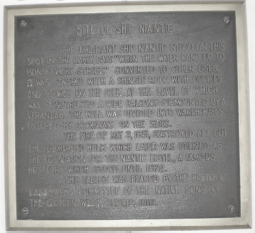|
The story of the Niantic is that of a ship
made rich, abandoned, remade, burned, buried, lost, re-found, and then lost
again |
|
The Niantic was one of many ships that brought
eager gold-seekers from around the world into Yerba Buena Cove (now San
Francisco) during the frenzied times of 1848-1849.
The Niantic was built in Connecticut in 1835, she was intended for sailing the
trade route between the U.S. and China. The amount of money to be made ferrying
gold hungry hopefuls to Yerba Buena Cove was staggering, and the Niantic made
over 38,000 dollars - over a million dollars in today's money - on its single
trip bringing gold seekers to California. Upon arrival in Yerba Buena, the
aspiring miners would abandon the ships, stock up on supplies, and race out to
take their chances panning for gold in the foothills.
The Niantic, however, had an unusual fate. It wasn't just the passengers that
were eager to try their luck in the gold game, and on the first day five of the
crew deserted, nine more left on the second day, and three more took off on the
third. (It may have been about more than just gold, as two of the deserting
sailors stabbed their Captain as part of their farewell.)
The ship, left with almost no crew, was simply floated out of the busy bay and
purposely run aground near what is now the intersection Clay and Montgomery
Streets.
 The
ship was subsequently converted for use as a store, warehouse, offices, and
hotel. Above the door cut into the vessel's side was the inscription "Rest for
the weary and storage for trunks." At high-tide the Clay Street Wharf was
accessible to small boats and “lighters” which would ferry cargo and passengers
from arriving ships anchored in Yerba Buena cove. The great fire of May 3, 1851
burned the ship down to the water-line. During the city's reconstruction the
remains of Niantic, along with other burned store-ships, were buried under
land-fill which extended the original shoreline to what is now the Embarcadero.
The nondescript Niantic Hotel was built on the site, it stood until 1872 when it
burned down, to be replaced by the Niantic Building which was destroyed in the
1906 Earthquake. The hull of the Niantic was "rediscovered" in 1978 during
excavation for the Mark Twain Plaza Complex. She still had some champagne left
in her hold along with other wares from her store-ship days. The
ship was subsequently converted for use as a store, warehouse, offices, and
hotel. Above the door cut into the vessel's side was the inscription "Rest for
the weary and storage for trunks." At high-tide the Clay Street Wharf was
accessible to small boats and “lighters” which would ferry cargo and passengers
from arriving ships anchored in Yerba Buena cove. The great fire of May 3, 1851
burned the ship down to the water-line. During the city's reconstruction the
remains of Niantic, along with other burned store-ships, were buried under
land-fill which extended the original shoreline to what is now the Embarcadero.
The nondescript Niantic Hotel was built on the site, it stood until 1872 when it
burned down, to be replaced by the Niantic Building which was destroyed in the
1906 Earthquake. The hull of the Niantic was "rediscovered" in 1978 during
excavation for the Mark Twain Plaza Complex. She still had some champagne left
in her hold along with other wares from her store-ship days.
Today a portion of the ship is in the San Francisco Maritime Museum while the
bow remains undisturbed under a parking lot, awaiting a future "rediscovery."
The Niantic is only one of around 50 ships now buried somewhere under San
Francisco's financial district.
In 1919, the Historic Landmarks Committee of the Native Sons of the Golden West
put up a plaque to mark the site.
Although virtually no sign remains visible above ground, memories and markers of
lost shipwrecks of San Francisco's early days can be found at the Old Ship
Saloon or by exploring the audio tour "The Armada of Broken Dreams". |

